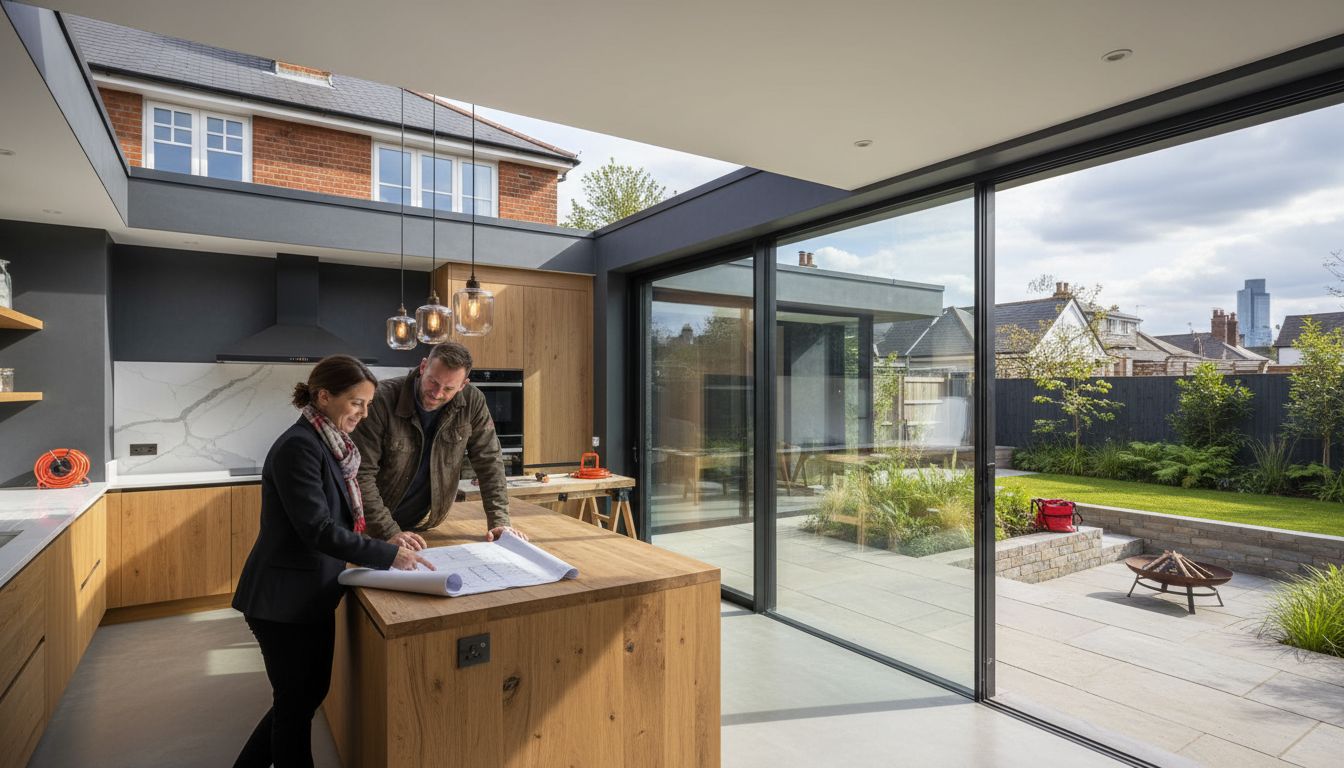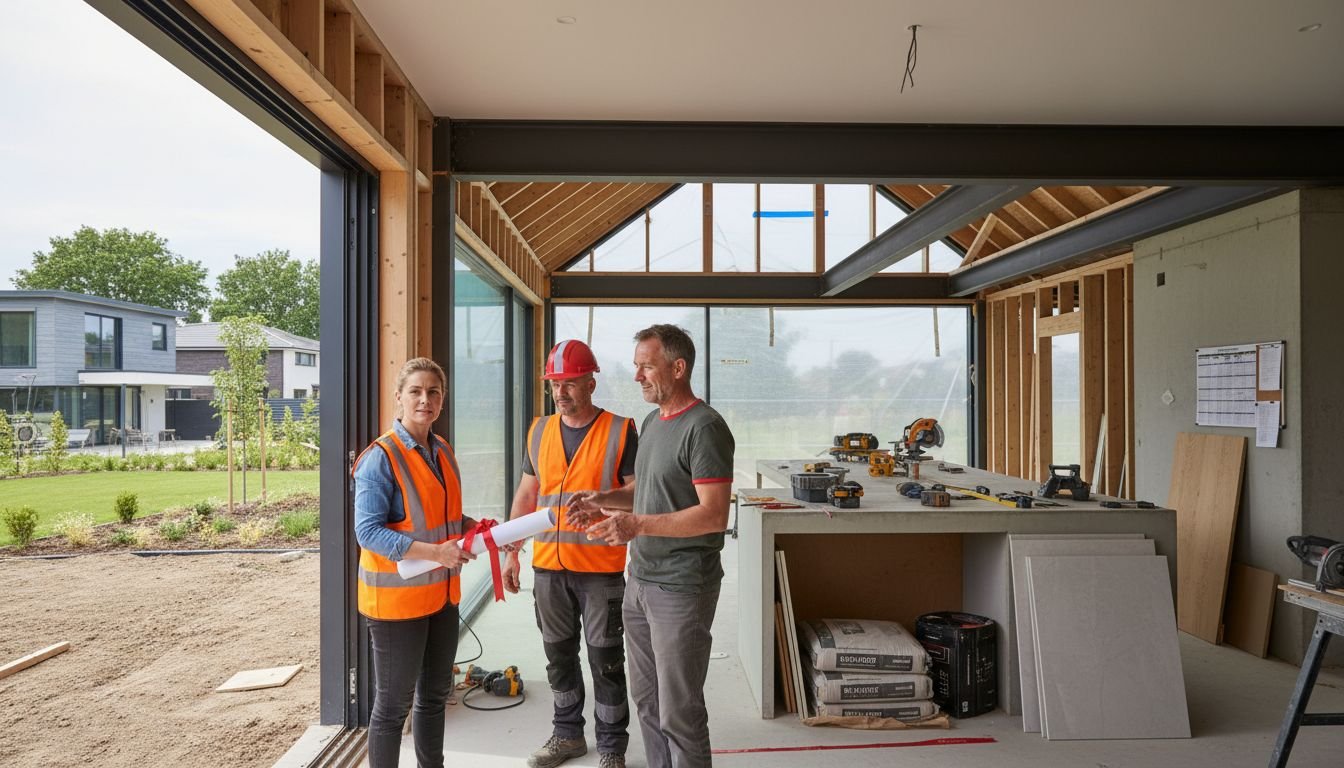Adding a home extension can lift your property value by as much as 20 percent, making it one of the smartest financial moves for homeowners today. The right kind of extension not only creates extra living space but also attracts future buyers who are willing to pay more for a well-designed upgrade. Understanding which features matter most and how local market trends affect value puts you in a strong position to get the best return from your investment.
Table of Contents
- What Makes A Home Extension Profitable
- Popular Types Of Home Extensions Explained
- Planning Permissions And Building Regulations UK
- Stage-By-Stage Cost Breakdown And ROI Factors
- Common Pitfalls And Maximising Extension Value
Key Takeaways
| Point | Details |
|---|---|
| Extension Types Matter | Choosing the right type of extension (e.g., rear, side, wraparound) significantly impacts functionality and property value. |
| Strategic Design is Key | Successful extensions require high-quality design that integrates seamlessly with existing architecture and meets market demands. |
| Financial Planning is Essential | Homeowners must understand cost breakdowns and potential ROI, as extensions can increase property value by 10-20%. |
| Avoid Common Pitfalls | Focus on using quality materials, ensuring proper design integration, and optimizing natural light to enhance extension value. |
What Makes a Home Extension Profitable
Profitable home extensions represent strategic investments that transform living spaces while simultaneously boosting property value. According to Property Secrets, specific extension types can dramatically increase a property’s market worth, making them financially intelligent home improvement choices.
The key factors determining an extension’s profitability include:
- Functional Space Expansion: Adding practical living areas like bedrooms, bathrooms, or open-plan kitchen spaces
- Quality of Design and Construction: Ensuring high-standard architectural integration and superior building work
- Local Property Market Dynamics: Understanding neighbourhood property value trends
- Return on Investment (ROI): Targeting improvements that generate more value than their initial construction costs
Statistical evidence suggests certain extension types yield higher financial returns. For instance, Property Secrets reveals that well-executed bedroom and bathroom additions can potentially increase property valuation by significant percentages. Smart homeowners focus not just on aesthetic improvements, but on strategic expansions that align with market demands and local buyer preferences.
Successful home extensions require meticulous planning, understanding current property market trends, and prioritising functional enhancements that appeal to potential future buyers. The most profitable extensions seamlessly blend architectural innovation with practical living solutions, transforming existing spaces into high-value property assets. Learn more about smart investment extensions to maximise your property’s potential and financial returns.
Popular Types of Home Extensions Explained
Home extensions come in various designs, each offering unique advantages for homeowners looking to expand their living spaces. According to Home Building, several popular extension types can transform your property’s functionality and value.
The most common home extension types include:
- Rear Extensions: Expanding the back of your property to create additional ground floor space
- Side Return Extensions: Utilising narrow side passages to widen existing rooms
- Wraparound Extensions: Combining rear and side extensions for maximum floor area
- Double-Storey Extensions: Adding significant space by expanding both ground and first floor levels
- Single-Storey Extensions: Providing ground floor room expansion with minimal structural complexity
UK Home Improvement highlights that each extension type requires careful consideration of planning permissions, architectural design, and local building regulations. Rear extensions, for instance, are particularly popular for creating open-plan kitchen and dining areas, while side return extensions can breathe new life into cramped Victorian and Edwardian homes.
Choosing the right extension depends on your property’s layout, budget, and specific space requirements.
 Homeowners should carefully evaluate their property’s structural potential and consult professionals to determine the most suitable extension type.
Homeowners should carefully evaluate their property’s structural potential and consult professionals to determine the most suitable extension type.
Explore our comprehensive guide on understanding home extension types to make an informed decision about transforming your living space.
Here’s a comparison of popular home extension types and their key features:
| Extension Type | Typical Use Case | Added Value Potential | Common Considerations |
|---|---|---|---|
| Rear Extension | Open-plan kitchen or dining | High | Planning permission Garden space |
| Side Return Extension | Widen existing rooms | Moderate | Structural integration Light levels |
| Wraparound Extension | Maximise ground floor space | Very High | Complex design Higher costs |
| Double-Storey | Increase ground and first floors | Maximum | Greater planning Neighbouring impact |
| Single-Storey | Expand ground floor | Moderate-High | Simpler build Limited upward space |
Planning Permissions and Building Regulations UK
Navigating the complex landscape of planning permissions and building regulations is crucial for homeowners considering a home extension. According to Planning Portal, understanding these legal requirements can mean the difference between a smooth project and potential costly legal complications.
Key aspects of planning permissions and building regulations include:
- Permitted Development Rights: Certain extensions can be built without formal planning permission
- Size and Location Restrictions: Specific limits on extension dimensions and property boundaries
- Building Regulation Approval: Mandatory technical standards for construction quality and safety
- Documentation Requirements: Detailed plans and drawings must be submitted for assessment
Government Guidelines highlight that most single-storey rear extensions up to 4 metres for detached homes and 3 metres for other property types can typically proceed under permitted development rights. However, homeowners must still adhere to strict criteria regarding height, materials, and overall design to ensure compliance.
Successful home extension projects demand meticulous planning and professional guidance.
 Consulting local planning authorities and experienced architects can help navigate the intricate regulatory landscape. Learn more about the house extension approval process to ensure your project meets all necessary legal requirements and proceeds smoothly.
Consulting local planning authorities and experienced architects can help navigate the intricate regulatory landscape. Learn more about the house extension approval process to ensure your project meets all necessary legal requirements and proceeds smoothly.
Stage-by-Stage Cost Breakdown and ROI Factors
Home extensions represent significant financial investments that require careful planning and strategic budgeting. Understanding the comprehensive cost breakdown and potential return on investment (ROI) is essential for homeowners looking to maximize their property’s value while managing expenses effectively.
Typical cost stages for a home extension include:
- Initial Design and Planning: Architectural fees, survey costs, and initial consultation expenses
- Pre-Construction Preparation: Site clearance, soil testing, and preliminary groundwork
- Construction Materials: Structural elements, building materials, and specialist components
- Labour Costs: Skilled tradespeople including builders, electricians, plumbers, and specialists
- Finishing and Interior Work: Flooring, painting, electrical fitting, and interior design elements
- Additional Expenses: Contingency funds, potential planning permission costs, and unexpected modifications
ROI factors depend on multiple variables, including extension type, property location, and quality of construction. A well-executed extension can typically increase property value by 10-20%, with kitchen and bathroom extensions often yielding the highest returns. Factors influencing potential value appreciation include design quality, functionality, architectural integration, and alignment with local property market trends.
Careful financial planning is crucial for a successful home extension project. Homeowners should create detailed budgets, include contingency funds, and consider long-term value alongside immediate costs. Explore our comprehensive guide on understanding extension costs and value to make informed financial decisions about your home improvement investment.
Common Pitfalls and Maximising Extension Value
Home extensions represent significant investments that require strategic planning and careful execution. Home Building warns that seemingly minor design choices can dramatically impact the overall value and aesthetic appeal of your property extension.
Common pitfalls that can diminish extension value include:
- Poor Material Selection: Using mismatched or low-quality building materials
- Inadequate Design Integration: Creating extensions that clash with existing architectural style
- Overlooking Functional Requirements: Designing spaces without considering practical usage
- Insufficient Natural Lighting: Neglecting window placement and light flow
- Ignoring Energy Efficiency: Failing to incorporate modern thermal performance standards
Home Building emphasises that successful extensions require careful consideration of style, functionality, and long-term property value. Homeowners should focus on creating seamless transitions between existing structures and new spaces, ensuring architectural cohesion and maintaining a consistent aesthetic that enhances overall property appeal.
Maximising extension value demands a holistic approach that balances design innovation with practical considerations. Professional guidance can help navigate complex design choices and avoid costly mistakes. Explore our guide on avoiding overspending and managing extension projects efficiently to ensure your home improvement investment delivers maximum return.
Unlock the Full Potential of Your Home Extension Project
If you are inspired by the idea of boosting your property’s value through a well-planned home extension, it is important to address common challenges such as navigating planning permissions, managing costs at every stage, and designing a stylish, functional space that truly adds value. This article highlights key aspects like maximising ROI, choosing the right type of extension, and avoiding pitfalls—all concerns that can feel overwhelming without expert guidance.
At Reltic Extend, we understand how vital it is to combine quality design with clear financial planning and smooth project management. Our team specialises in bespoke extensions across London and Surrey, offering transparent, stage-by-stage pricing alongside professional handling of all planning permissions. Explore our Cost & Value of Home Extensions | Reltic Extend resource to see how we help homeowners make smart investments that enhance their living spaces and improve long-term property value.
Are you ready to transform your home with confidence and maximise the potential of your extension? Discover tailored design and build solutions in our Design & Build Tips for Home Extensions | Reltic Extend. Contact us today at Reltic Extend and take the first step towards a seamless, professionally managed home extension that delivers real results.
Frequently Asked Questions
What types of home extensions are considered most profitable?
Profitable home extensions typically include rear extensions, side return extensions, wraparound extensions, double-storey extensions, and single-storey extensions. Each type offers varying benefits in terms of space expansion and potential return on investment.
How do I determine the return on investment (ROI) for my home extension?
Calculating ROI for your home extension involves assessing the increased property value against the costs associated with construction. A well-executed extension can yield a return of 10-20%, with kitchen and bathroom extensions often providing the highest returns.
What are the key factors to consider when planning a home extension?
Key factors include functional space expansion, quality of design and construction, understanding local property market dynamics, and ensuring compliance with planning permissions and building regulations.
What common pitfalls should I avoid when planning a home extension?
Common pitfalls include poor material selection, inadequate design integration, overlooking functional requirements, insufficient natural lighting, and ignoring energy efficiency. To maximize value, ensure cohesion with existing architecture and consider long-term functionality.





